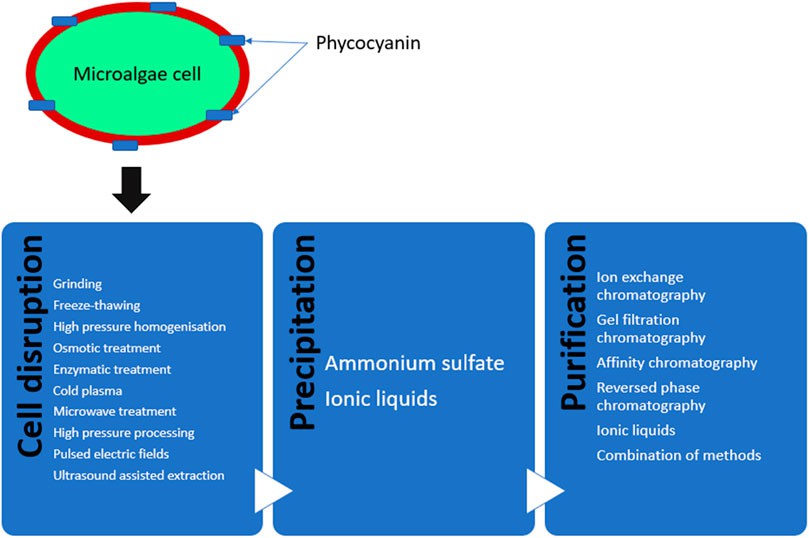Advanced extraction techniques with environmental goodness are realized to recover the target bioactive compounds of microalgae in an efficient extraction procedure while minimizing the use of toxic organic solvents. A crude extract of the microalgae is generally obtained in this way, where the biomolecules are usually mixed or blended with the solvent into a single phase. Therefore, it is necessary to separate the active compounds of interest from the most minor interesting compounds or to remove impurities, which can reduce their value or introduce some toxicity. Scientists have successfully developed several separation methods to purify bioactive compounds from extracted microalgae. Once the target bioactivity is obtained, the next step is to characterize the bioactive components present in the initial extract chemically, often referred to as lead functional components.
 Fig 1. Schematic representation of different methods for the extraction, purification and analysis of phycocyanin from microalgae. (Halim R, et al., 2022)
Fig 1. Schematic representation of different methods for the extraction, purification and analysis of phycocyanin from microalgae. (Halim R, et al., 2022)
For many years, we have been working on extracting bioactive compounds from microalgae by using different simple and cost-effective methods that have been widely welcomed by our customers worldwide. Here, Lifeasible focuses on the purification and chemical characterization of the bioactive components present in the initial microalgae extracts. Our goal is to obtain highly efficient and pure target compounds from microalgae and to analyze the correlation between their chemical composition and the observed biological activity.
Depending on the solubility of the initial microalgae extract, its stability at different pH conditions and thermal stability, and the nature of the suspected bioactive compound in your project, we will select the best analytical technique for purification and characterization. To maximize the identification potential of bioactive compounds from microalgae, our scientists use various advanced analytical techniques, even coupled techniques.
We use electrophoresis and two-dimensional electrophoresis to separate water-soluble and insoluble proteins from a wide range of microalgae, such as Porphyridium cruentum, Erysipelas rainforest, and Chlorella.
We use ultrafiltration and electro-membrane filtration methods to purify carotenoids from Chlorella.
We use this method to remove impurities such as chlorophyll, and cellular debris from cyanobacterial protein extracts.
We use this method to purify various microalgal biomolecules such as pigments, proteins, enzymes, amino acids, antibodies, etc.
We use this method to recover proteins from Chlorella biomass.
We use this method to isolate enzymes and proteins from Chlorella biomass.
Our expert technicians will select the best analytical technique for your purification and characterization based on the solubility of the initial microalgae extract, its stability at different pH conditions, thermal stability, and the nature of the suspected bioactive compounds. If you are interested in our solutions for purification and chemical characterization of microalgal bioactives, please contact us directly.
Reference
Lifeasible has established a one-stop service platform for plants. In addition to obtaining customized solutions for plant genetic engineering, customers can also conduct follow-up analysis and research on plants through our analysis platform. The analytical services we provide include but are not limited to the following:
STU-CRISPR System Improves Plant Genome Editing Efficiency
April 19, 2024
Application of Exosomes in Facial Beauty
April 12, 2024